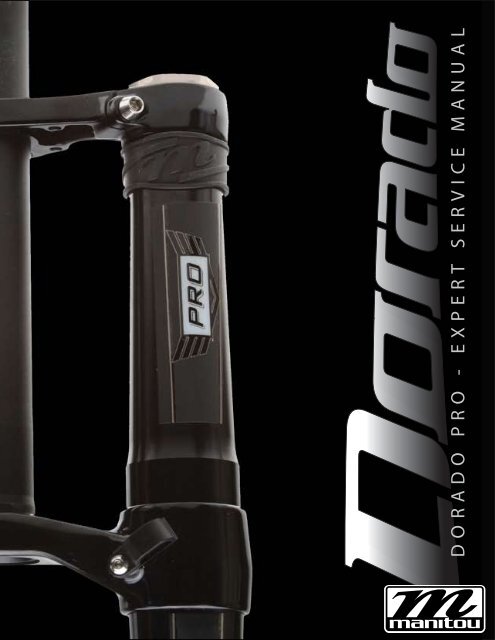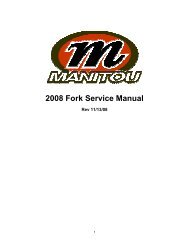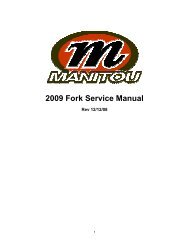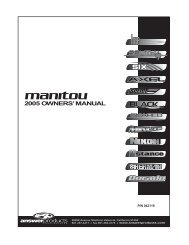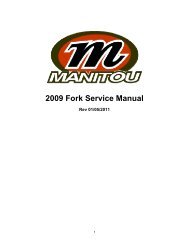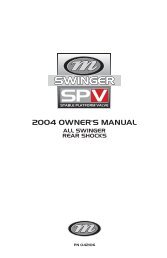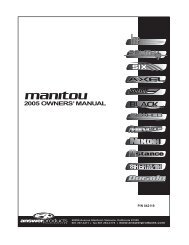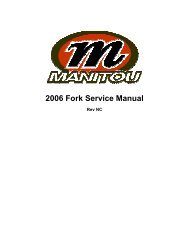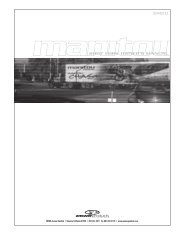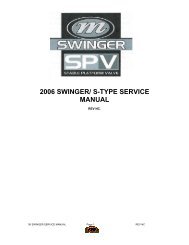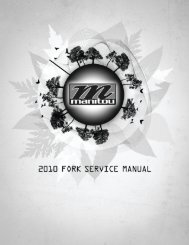Dorado Pro Service Manual - Manitou
Dorado Pro Service Manual - Manitou
Dorado Pro Service Manual - Manitou
You also want an ePaper? Increase the reach of your titles
YUMPU automatically turns print PDFs into web optimized ePapers that Google loves.
D O R A D O P R O - E X P E R T S E R V I C E M A N U A L
Table of Contents<br />
Table of Contents<br />
Section<br />
Page Number<br />
<br />
Introduction and Required Tool List<br />
-<br />
Damping Leg <strong>Service</strong> – Disassembly -9<br />
Damping Leg <strong>Service</strong> - Assembly<br />
Air Leg <strong>Service</strong> - Disassembly<br />
Compression Rod <strong>Service</strong><br />
Air Leg <strong>Service</strong> - Assembly<br />
Dust and Oil Seal Replacement<br />
Exploded Diagram & Parts List<br />
O-Ring Placement Diagrams<br />
0-<br />
-<br />
-9<br />
0-<br />
-<br />
<br />
-8<br />
Contact Information<br />
Hayes Bicycle Group<br />
800 W Donges Bay Rd<br />
Mequon, WI 09<br />
Toll Free:<br />
Direct:<br />
FAX:<br />
E-mail:<br />
Web site:<br />
(888) 686-7<br />
(6) -00<br />
(6) -9<br />
techsupport@hayesbicycle.com<br />
www.manitoumtb.com<br />
<br />
SERVICE MANUAL
INTRODUCTION<br />
This manual is intended to guide the user through basic service of <strong>Manitou</strong> <strong>Dorado</strong> <strong>Pro</strong> and<br />
Expert front forks. We highly suggest the service on these forks be performed by an experienced<br />
suspension mechanic. <strong>Service</strong> is supported by the identification of common parts and assemblies<br />
that have been assembled into <strong>Service</strong> Kits. The purpose of this manual will be to describe<br />
conditions that may drive the need for service and to provide installation instructions for the kits.<br />
Due to the time-consuming nature of suspension fork service, at this time our primary focus is to<br />
offer service kits that minimize the amount of downtime and labor involved. Please read through<br />
the manual carefully before beginning the service of your fork. The <strong>Dorado</strong> fork service is<br />
considerably more involved than a standard fork service and having a basic understanding of the<br />
tasks you are about to perform will assist you greatly in the disassembly and re-assembly of your<br />
fork.<br />
Please read through the required tools page and be sure you have all of the items you will need<br />
for the service of your fork. The guide is designed to be used with the <strong>Dorado</strong> <strong>Service</strong> kit which<br />
includes all O-rings and seals to overhaul the fork. The part number for the kit is 141-25995.<br />
For any assistance with the service of your <strong>Dorado</strong> please contact our Technical <strong>Service</strong><br />
Department at 888-686-3472 and email them at techsupport@hayesbicycle.com<br />
GENERAL WARNING: Suspension forks by design can contain preloaded springs, gases<br />
and fluids under extreme pressure and warnings contained in this manual must be<br />
observed to reduce the possibility of injury or possible death. Following these<br />
instructions can help you reduce the risk of being injured. Any questions in regards to the<br />
information in this manual should be directed to <strong>Manitou</strong> Customer <strong>Service</strong> at (888) 686-<br />
7.<br />
CAUTION: Suspension forks use precision machined aluminum and other soft alloy<br />
components. Using correct tools for assembly is essential to prevent damage.<br />
<br />
SERVICE MANUAL
REQUIRED TOOLS<br />
Below is a list of tools that will be used in the complete service of a<br />
<strong>Dorado</strong> <strong>Pro</strong>/Expert fork.<br />
<strong>Dorado</strong> Clamp Blocks – <strong>Manitou</strong> Part Number 172-25077<br />
<strong>Dorado</strong> Seal Press – <strong>Manitou</strong> Part Number 172-29862<br />
<strong>Dorado</strong> <strong>Service</strong> Kit – Includes all O-rings and seals for service. Part<br />
number 141-25995<br />
M-Prep Grease – <strong>Manitou</strong> Part Number 85-0031<br />
Semi-bath Oil – <strong>Manitou</strong> Part Number 85-0023<br />
wt Fork Oil<br />
Torque Wrench<br />
6mm Wrench or Socket (an adjustable wrench can be used<br />
instead but care must be taken to not damage the top caps.)<br />
mm Combination Wrench<br />
mm Combination Wrench<br />
0mm Combination Wrench<br />
20mm Crow’s Foot<br />
mm Allen Wrench<br />
.mm Allen Wrench<br />
mm Allen Wrench<br />
6mm Allen Wrench<br />
6mm Socket with ratchet<br />
Small Flat Blade Screwdriver<br />
Needle Nose Pliers<br />
Pick or similar tool for removing O-rings<br />
Blue Loctite<br />
Safety Glasses<br />
Isopropyl Alcohol<br />
<br />
SERVICE MANUAL
Damping Leg <strong>Service</strong><br />
Disassembly<br />
1. First step is to loosen the damping leg top<br />
cap using a 36mm wrench. It helps if the leg<br />
is still clamped in the lower crown assembly<br />
while breaking the top cap loose (be sure the<br />
upper crown is loosened, you only want the lower<br />
tightened when breaking loose the top cap). Only<br />
loosen the top cap at this point. Do not remove it.<br />
(FIG. 1)<br />
2. Loosen the pinch bolts on the lower crown<br />
and remove the damping leg from the fork. You<br />
will need to remove the frame bumpers to do so.<br />
Put them in a safe place so you do not misplace<br />
them.<br />
FIG. 1<br />
3. Clamp the upper sleeve of the fork in bike<br />
stand.<br />
4. Remove the top cap from the fork leg using a<br />
36mm wrench. The top cap is still attached to the<br />
rebound shaft at this point.<br />
5. You will now remove the top cap from the rebound<br />
shaft. Place a 12mm wrench on the flats of<br />
the rebound shaft and use a 36mm wrench to unthread<br />
the top cap from the shaft. (FIG. 2) Once<br />
the top cap is unthreaded, remove the rebound<br />
knob from the top cap.<br />
FIG. 2<br />
6. Remove the fork leg from the bike stand and<br />
pour the oil out of the leg. (FIG. 3) Slide the inner<br />
leg out of the outer leg and leave the outer leg to<br />
drain in a drainage pan.<br />
7. Holding the inner leg over a drainage pan,<br />
stroke the rebound shaft several times to drain<br />
the rest of the oil from the inner leg.<br />
FIG. 3<br />
<br />
SERVICE MANUAL
8. Wrap the inner leg in a rag and lightly clamp it<br />
into a bike stand with the rebound shaft pointing<br />
down towards the floor.<br />
9. Using a 2mm Allen wrench, remove the TPC+<br />
adjuster knob. Remove O-ring and be sure you<br />
capture the 2 detent balls and springs under the<br />
knob. (FIG. 4, 5 & 6)<br />
10. Next you will remove the High Speed adjuster<br />
knob. Remove the c-clip that holds the knob<br />
on using a small flat blade screwdriver or similar<br />
tool. (FIG. 7) Once the c-clip is removed pull the<br />
knob up. Be sure to capture the O-ring, 2 detent<br />
balls and springs under the knob. (FIG. 8)<br />
FIG. 6<br />
FIG. 4<br />
FIG. 7<br />
FIG. 5<br />
FIG. 8<br />
<br />
SERVICE MANUAL
11. Remove the damping cartridge from the inner<br />
leg using a 26mm socket. Pull the damping<br />
cartridge completely out of the inner leg. (FIG. 9<br />
&10)<br />
12. You will notice the damping cartridge has two<br />
larger diameter sections at the ends. These are<br />
called the Outer Cartridge Adapters. Using the<br />
<strong>Dorado</strong> Clamp Blocks (Part # 172-25077), clamp<br />
the outer cartridge adapter on the rebound end in<br />
a vise.<br />
13. Using a 20mm wrench, remove the rebound<br />
damper from the cartridge. (The inner cartridge<br />
tube will come out with either the rebound assembly<br />
or compression assembly. If it comes<br />
out with the rebound, pull the tube off of the<br />
assembly.) (FIG. 11 & 12)<br />
FIG. 10<br />
FIG. 11<br />
FIG. 9<br />
FIG. 12<br />
<br />
SERVICE MANUAL
14. Replace the following O-rings on the rebound<br />
damper assembly. You can also refer to the Rebound<br />
Assembly Diagram on Page 23 to see the<br />
placement of the O-rings on the assembly.<br />
A. O-ring #064962 - This is the O-ring above<br />
the threads on the end of the damper assembly.<br />
(FIG. 13)<br />
B. O-ring #100-121 - This is the larger O-ring on<br />
the bottom out end cap. (FIG. 14)<br />
C. O-ring #100-014 - This is the smaller O-ring<br />
on the bottom out end cap. (FIG. 15)<br />
FIG. 13<br />
FIG. 14<br />
FIG. 15<br />
<br />
SERVICE MANUAL
15. Clamp the outer cartridge adapter on the<br />
compression damper side using the <strong>Dorado</strong><br />
Clamp Blocks. (FIG. 16)<br />
16. Remove the TPC+ Compression assembly<br />
from the cartridge using a 26mm socket. (The<br />
inner cartridge tube will come out with either the<br />
rebound assembly or the compression assembly.<br />
Pull the tube off of the assembly.) (FIG. 17 & 18)<br />
17. Remove the top cap and nylon washer from<br />
the assembly. This is required to replace the O-<br />
rings included in the service kit for the compression<br />
assembly. (FIG. 19)<br />
FIG. 17<br />
FIG. 16<br />
FIG. 19<br />
FIG. 18<br />
<br />
SERVICE MANUAL
18. Replace the following O-rings on the compression<br />
assembly top cap.<br />
A. O-ring # 08-29433-L026 - This is the O-ring<br />
that is around the outside of the compression assembly<br />
top cap. (FIG. 20)<br />
B. O-ring # 100-023 - This O-ring is located in an<br />
inside groove in the top cap. It is directly behind<br />
the two pins. (FIG. 21)<br />
C. O-ring # 101-1250-200 - This O-ring is<br />
located just below the top opening on the top cap<br />
where the adjuster slides through. (FIG. 22)<br />
19. Press the top cap back onto the compression<br />
assembly. (FIG. 23)<br />
FIG. 22<br />
FIG. 20<br />
FIG. 23<br />
FIG. 21<br />
<br />
SERVICE MANUAL
Damping Leg <strong>Service</strong><br />
Assembly<br />
1. Inspect the inner and outer damper tubes<br />
and be sure they are free from debris and<br />
contaminants.<br />
2. Press the inner damper tube onto the rebound<br />
assembly.<br />
3. Clean the threads on the outer cartridge<br />
adapter with isopropyl alcohol and apply Blue<br />
Loctite to the threads. Install the rebound damper<br />
assembly into the outer cartridge. Only tighten to<br />
hand tight at this point.<br />
FIG. 1<br />
4. Clean the threads on the second outer<br />
cartridge adapter and apply blue Loctite to them.<br />
Install the TPC+ compression assembly into the<br />
cartridge.<br />
5. Using a 26mm socket and 20mm wrench,<br />
tighten both the compression assembly and<br />
rebound assembly to 6.8 Nm (60 in lbs).<br />
(FIG. 1 &2)<br />
FIG. 2<br />
6. Put a small amount of Prep M grease on the<br />
O-ring on the rebound end of the damper cartridge<br />
assembly. Install the assembly in the inner<br />
leg by sliding it into the bottom of the leg. Use a<br />
26mm socket to tighten it into the leg. Tighten to<br />
6.8 Nm (60 in lbs). (FIG. 3)<br />
FIG. 3<br />
10<br />
SERVICE MANUAL
7. Insert the detent springs into opposite holes in<br />
the end cap and place the detent balls on top of<br />
the springs. To hold the detent balls in place on<br />
the spring use a small dab of grease. (FIG. 4)<br />
8. Install the high speed adjuster onto the end<br />
cap. Be sure that O-ring # 100-025 below the<br />
adjuster is in place and greased. (FIG. 5) Secure<br />
the adjuster with the c-clip.<br />
9. Insert the springs into opposite holes on the<br />
TPC+ adjuster knob and then place the detent<br />
balls in the corresponding holes of the high speed<br />
adjuster knob. (FIG. 6) Place O-ring # 100-024<br />
around the TPC+ knob and apply a small amount<br />
of grease to it. (FIG. 7)<br />
10. Install the TPC+ adjuster knob onto the end<br />
cap and secure with the 2mm screw. (FIG. 8)<br />
FIG. 6<br />
FIG. 4<br />
FIG. 7<br />
11<br />
FIG. 5<br />
SERVICE MANUAL<br />
FIG. 8
11. Replace the oil and dust seals on the outer<br />
leg following the directions on pages 22-23. Inspect<br />
the inside of the outer leg and the outside<br />
of the inner leg and be sure they are free from<br />
debris and contaminants. Lube the oil seal and<br />
dust wiper on the outer leg with a small amount<br />
of Prep M grease. Slide the inner leg into the<br />
outer leg and clamp into the bike stand.<br />
12. Replace O-ring # 100-027 on the top cap<br />
(FIG. 9)<br />
13. Install the top cap onto the end of the rebound<br />
shaft. Use a 36mm wrench and a 12mm<br />
wrench to tighten to the proper torque of 6.8-9.0<br />
Nm (60-80) in lbs).<br />
FIG. 9<br />
14. Install the rebound knob into the top cap by<br />
snapping it into place. Fully close the rebound<br />
by turning the knob clockwise.<br />
15. Fully extend the rebound shaft, pulling the<br />
inner leg up into the outer leg.<br />
16. Pour damper oil (5wt fork oil) into the leg.<br />
Stroke the rebound shaft to bleed the system<br />
and release the air. You want to stroke the rebound<br />
shaft a few times with the rebound fully<br />
closed, then turn the rebound knob open two<br />
clicks counterclockwise. Stroke the rebound<br />
shaft another 15-20 times and the system will be<br />
bled. (FIG. 10)<br />
FIG. 10<br />
17. Once the system is bled you need to set<br />
the oil height in the leg. The oil height is 110mm.<br />
You measure this by measuring down from the<br />
top of the outer leg to the top of the oil. You want<br />
the inner leg fully compressed into the outer leg<br />
when measuring. (FIG. 11)<br />
18. After you have properly set the oil height<br />
fully extend the inner leg and tighten down the<br />
top cap using a 36mm wrench to the proper<br />
torque of 6.8-9.0 Nm (60-80 in lbs).<br />
19. Reinstall the damping leg into the fork<br />
crowns on the bike.<br />
FIG. 11<br />
12<br />
SERVICE MANUAL
Air Spring Leg <strong>Service</strong><br />
Disassembly<br />
1. First, the air pressure needs to be released<br />
from the system. Remove the air cap from the<br />
top of the fork leg, and release the air pressure<br />
using a shock pump. (FIG. 1)<br />
2. The air spring leg top cap needs to be loosened.<br />
Loosen the pinch bolt on the top crown,<br />
and crack the top cap loose with a 36mm wrench.<br />
(FIG. 2)<br />
FIG. 2<br />
3. Loosen the pinch bolts on the lower crown,<br />
and remove the leg from the fork. Be sure not<br />
to misplace the frame bumper that will need to<br />
come off the fork leg. (FIG. 3)<br />
4. Lightly clamp the fork leg in a bike stand.<br />
Remove the top cap from the leg with a<br />
36mm wrench. Remove the top cap from the<br />
compression rod with a 13mm wrench on the<br />
top of the compression rod and a 36mm wrench.<br />
(FIG. 4)<br />
FIG. 3<br />
FIG. 1<br />
FIG. 4<br />
13<br />
SERVICE MANUAL
5. Pour the fluid out of the leg, and slide the<br />
inner leg out of the outer leg. Remove the outer<br />
leg from the stand and let it sit above a drainage<br />
pan. (FIG. 5)<br />
6. Wrap the inner in a rag and clamp it lightly in<br />
the bike stand with the compression rod pointing<br />
towards the ceiling.<br />
7. Loosen the Compression Rod Assembly from<br />
the inner leg with a 20mm wrench. (FIG. 6)<br />
8. Remove Compression Rod Assembly from<br />
the inner leg. Note: there will be a small amount<br />
of Semi-bath oil on top of the piston. (FIG. 7)<br />
FIG. 5<br />
FIG. 6<br />
FIG. 7<br />
14<br />
SERVICE MANUAL
Compression Rod <strong>Service</strong><br />
This section covers the complete tear down and<br />
rebuild of the air spring compression rod in the<br />
air leg of the fork.<br />
1. Using the <strong>Dorado</strong> Clamp Blocks (Part # 172-<br />
25077), clamp the compression rod in a vise.<br />
Be sure to clamp the compression rod near the<br />
end or below the air piston. Do not clamp in the<br />
middle of the shaft. (FIG. 1) Do not clamp the rod<br />
in a vise without the clamp blocks. Doing so will<br />
damage the rod rendering it unusable.<br />
FIG. 2<br />
2. Next you need to unthread the poppet from<br />
the valve shaft. Insert a 2.5mm Allen wrench into<br />
the center hole of the air piston. (FIG. 2 & 3) You<br />
may have to turn and push lightly on the wrench<br />
until you feel it engage the Allen head inside the<br />
shaft. Turn the wrench counter-clockwise. You<br />
will notice as you are turning the wrench the<br />
valve shaft is moving out of the valve housing<br />
on the other end of the compression rod. (FIG.<br />
4) Keep turning the wrench until the valve shaft<br />
stops moving out of the housing.<br />
FIG. 3<br />
FIG. 1 FIG. 4<br />
15<br />
SERVICE MANUAL
3. Using a 13mm wrench unthread the valve<br />
assembly off of the compression shaft and<br />
remove the air valve shaft from the compression<br />
rod shaft. (FIG. 5 & 6)<br />
4. Slide the travel spacer, bottom-out<br />
bumper and end cap off of the compression<br />
shaft. (FIG. 7)<br />
5. Using a 6mm Allen wrench unthread the air<br />
piston off of the compression shaft. (FIG. 8)<br />
Be careful when removing the piston as there<br />
is a small spring in the shaft under the piston.<br />
(FIG. 9)<br />
FIG. 7<br />
FIG. 5<br />
FIG. 8<br />
FIG. 6<br />
FIG. 9<br />
16<br />
SERVICE MANUAL
6. Insert the valve shaft back into the<br />
compression rod shaft and use it to push the<br />
poppet out of the other end of the compression<br />
rod shaft. (FIG. 10 & 11)<br />
7. Replace O-rings #101-350-150 on the poppet.<br />
(FIG. 12)<br />
8. Replace O-ring #100-214 on the air piston.<br />
(FIG. 13)<br />
FIG. 12<br />
FIG. 10<br />
FIG. 13<br />
FIG. 11<br />
17<br />
SERVICE MANUAL
9. Replace O-rings 100-026 and 100-110 on the<br />
end cap. (See Page 26, FIG A) Install the end<br />
cap, bottom-out bumper and the travel spacer<br />
back onto the compression rod shaft. (FIG. 14 &<br />
15)<br />
10. Apply a small amount (too much Loctite will<br />
clog the air shaft assembly) of red Loctite to the<br />
threads of the valve assembly. (FIG. 16) Lightly<br />
grease valve shaft and insert both the valve<br />
shaft and valve assembly into compression rod.<br />
Tighten to 45 -55 in lbs [5.1 - 6.2 Nm]<br />
(FIG. 17 & 18)<br />
FIG. 16<br />
FIG. 14<br />
FIG. 17<br />
FIG. 15<br />
FIG. 18<br />
18<br />
SERVICE MANUAL
11. Replace O-ring #064962 on the threaded<br />
end of the compression rod shaft. (FIG. 19)<br />
12. Insert poppet into compression rod shaft.<br />
(FIG . 20)<br />
13. Insert poppet spring into air piston and<br />
thread into compression rod shaft. (FIG. 21)<br />
Tighten air piston to 45-55 in lbs [5.1 - 6.2 Nm]<br />
14. Insert a 2.5mm Allen wrench into the<br />
center of the air piston and push lightly until you<br />
feel it engage on the poppet. (FIG. 22) Turn the<br />
poppet clockwise, threading it onto the valve<br />
shaft. Tighten it until the valve shaft protrudes<br />
from the valve housing 1mm. (FIG. 23)<br />
FIG. 21<br />
FIG. 19<br />
FIG. 22<br />
FIG. 20<br />
FIG. 23<br />
19<br />
SERVICE MANUAL
Air Spring <strong>Service</strong><br />
Assembly<br />
1. Inspect the inner leg, inside and out, and be<br />
sure it is free from debris and contaminants.<br />
2. Lube the air piston on the Compression Rod<br />
Assembly with a small amount of Semi Bath oil<br />
(5/40wt. Synthetic oil, P/N: 85-0023), and slide it<br />
into the top of the inner leg. (FIG. 1)<br />
3. Inject 10cc of Semi Bath oil (5/40wt. Synthetic<br />
oil, P/N: 85-0023) into the inner leg on top<br />
of the air piston. (FIG. 2)<br />
FIG. 2<br />
4. Use a 20mm crows foot to tighten the air<br />
spring end cap to the proper torque of 6.8-9.0<br />
Nm (60-80 in lbs). (FIG. 3)<br />
5. Replace the oil and dust seals on the outer<br />
leg following the directions on pages 22-23.<br />
Inspect the inside of the outer leg, and be sure it<br />
is free from debris and contaminants. Lube the<br />
oil seal and dust wiper on the end of the outer<br />
leg with Prep M grease (Ref Answer <strong>Pro</strong>ducts<br />
PN 85-0031). (FIG. 4) Slide the inner leg into the<br />
outer leg, and clamp the top of the outer leg in<br />
the bike stand.<br />
FIG. 3<br />
FIG. 1 FIG. 4<br />
20<br />
SERVICE MANUAL
6. Replace O-ring #100-027 on the top cap.<br />
(FIG. 5)<br />
7. Install the top cap onto the end of the compression<br />
rod. Use a 36mm wrench and a 13mm<br />
wrench to tighten to the proper torque of 6.8-9.0<br />
Nm (60-80 in lbs) (FIG. 6)<br />
8. Inject 30cc of Semi Bath oil (5/40wt. Synthetic<br />
oil, P/N: 85-0023) into the outer leg on top<br />
of the inner leg. (FIG. 7)<br />
9. Fully extend the inner leg and tighten down<br />
the top cap to the proper torque of 6.8-9.0 Nm<br />
(60-80 in lbs). (FIG. 8)<br />
FIG. 6<br />
10. Fill the fork to the desired air pressure. (50-<br />
90psi)<br />
FIG. 7<br />
FIG. 5<br />
FIG. 8<br />
21<br />
SERVICE MANUAL
Dust and Oil Seal<br />
Replacement<br />
1. Using a pick or small blade screwdriver<br />
remove the wear ring from the outer leg. (FIG. 1)<br />
2. Gently pry out the old dust seal from the outer<br />
leg. A tool we have found that works well is a<br />
downhill tire lever. If using a flat blade<br />
screwdriver to remove the seal be careful the tip<br />
of the blade does not catch on the lip inside the<br />
outer leg. (FIG. 2)<br />
FIG. 1<br />
3. Using a pick or small flat blade screwdriver<br />
remove the retaining ring on top of the oil seal.<br />
(FIG. 3)<br />
4. Gently pry out the old oil seal from the outer<br />
leg. (FIG. 4)<br />
5. Place the new oil seal into the outer leg. Be<br />
sure the side with the lip and garter spring is<br />
facing upwards. Use the smooth side of the<br />
<strong>Dorado</strong> Seal Press to press in the new oil seal<br />
until it stops. (FIG. 5 & 6)<br />
6. Place the retaining ring on top of the oil seal.<br />
Ensure that it snaps completely into the groove<br />
on the inside of the leg. (FIG. 7)<br />
FIG. 2<br />
7. Place the new dust seal into the leg and use<br />
the knurled end of the <strong>Dorado</strong> Seal Press to<br />
press it complete into the leg. (FIG. 8)<br />
8. Install the wear ring back onto the outer leg.<br />
FIG. 3<br />
22<br />
SERVICE MANUAL
FIG. 4<br />
FIG. 7<br />
FIG. 5<br />
FIG. 8<br />
FIG. 6<br />
23<br />
SERVICE MANUAL
DRAWING # PART DESCRIPTION<br />
DORADO PRO<br />
PART NUMBER<br />
DORADO EXPERT<br />
PART NUMBER<br />
1 Schrader Cap 141-25993 141-25993<br />
2 Top Air Cap 141-24111 141-24111<br />
3 Knob Kit 141-24109 141-24109<br />
4 Rebound Top Cap 141-24801 141-24801<br />
5 Compression Rod 141-25983 141-25983<br />
6<br />
Complete Cartridge (contains parts a, b and c<br />
assembled 141-24104 141-24104<br />
a. Compression Damper 141-24103 141-24103<br />
b. Rebound Damping Assembly 141-24102 141-24102<br />
c. Cartridge Tube 141-241222 141-241222<br />
7 Bottom Air Cap 141-26018 141-26018<br />
8 Left Inner Leg 141-25985 141-29609-K002<br />
9 Right Inner Leg 141-25986 141-29609-K003<br />
10 Complete <strong>Service</strong> Kit (also includes all o-rings) 141-25995 141-25995<br />
11 Outer Leg 141-25982 141-29609-K004<br />
12 Lower Crown/Steer 141-25987 141-29609-K005<br />
DETAIL A<br />
6<br />
SEE<br />
DETAIL A<br />
3<br />
10<br />
11<br />
7<br />
9<br />
4<br />
DORADO EXPERT<br />
PART NUMBER<br />
DORADO PRO<br />
PART NUMBER<br />
PART DESCRIPTION<br />
141-29609-K006 141-25988 Top Crown (Large)<br />
141-29609-K007 141-25990 Top Crown (Small)<br />
141-28073-K003 141-28073-K003 Leg Guards<br />
141-24116 141-24116 Frame Bumpers<br />
141-23817 141-23817 IS/Post Mount Brake Mount Brackets<br />
141-24119 141-24119 Thru Axel w/end bolt<br />
141-25991 141-25991 Thru Axel Hardware<br />
12<br />
3<br />
1<br />
5<br />
8<br />
24<br />
SERVICE MANUAL
REBOUND DAMPER ASSEMBLY<br />
O-RING PLACEMENT<br />
NOTE: O-RINGS ARE NOT TO SCALE<br />
25<br />
SERVICE MANUAL
COMPRESSION ROD ASSEMBLY<br />
O-RING PLACEMENT<br />
FIGURE A<br />
SEE FIGURE A<br />
FIGURE B<br />
This is the poppet that is located inside<br />
the compression damper shaft. Please<br />
see the service manual section that<br />
shows the dissasembly of the<br />
compression rod..<br />
NOTE: O-RINGS ARE NOT TO SCALE<br />
26<br />
SERVICE MANUAL
COMPRESSION DAMPER<br />
O-RING PLACEMENT<br />
08-29433-L026<br />
NOTE: O-RINGS ARE NOT TO SCALE<br />
27<br />
SERVICE MANUAL
TOP CAP & COMPRESSION DAMPER KNOB<br />
O-RING PLACEMENT<br />
100-024<br />
100-025<br />
100-027<br />
NOTE: O-RINGS ARE NOT TO SCALE<br />
28<br />
SERVICE MANUAL


